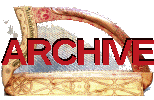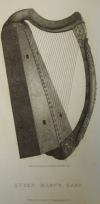

|
The Queen Mary harp used to be kept at Lude House, Perthshire, along with the Lamont harp. According to the family tradition, reported by Gunn, the Queen Mary harp was presented to Beatrix Gardyn by Mary, Queen of Scots, in the 16th century.
Unfortunately we have no information about how Mary might have got the harp, or of its history going back to its original construction. Most scholars suggest that it may have been made in 15th century in Argyll or the Isles.
Beatrix passed the harp down to her descendents, but since she married twice it is not clear to me which family had the harp - the Robertsons of Lude or the Farquharsons of Invercauld. In any case, by the beginning of the 18th century, John Robertson of Lude married Margaret Farquharson of Invercauld, and the harp was at Lude after that.
John Robertson (who died c.1730) was the last to play the Queen Mary harp in the old tradition; his music was written down and published.
 Gunn, 1807
Gunn, 1807
In 1805 John Robertson's great-grandson, General William Robertson, loaned the two harps to the Highland Society where they were exhibited in Edinburgh; both were drawn and described by John Gunn, and the Queen Mary harp was strung with gut pedal harp strings and played upon by the fashionable pedal harpist Elois.
The two harps were exhibited on loan at the National Museum in Edinburgh from 1880 and were put up for sale in 1904 - the Queen Mary harp was purchased by the Museum for £890, and remains on display in the National Museum today.
John Gunn, An Historical Enquiry respecting the Performance on the Harp in the Highlands of Scotland, Archibald Constable, Edinburgh, and John Murray, London, 1807
Keith Sanger & Alison Kinnaird Tree of Strings (Crann nan Teud), (Kinmor Music, Scotland, 1992
Keith Sanger, Lude: The Robertson family and their harps, 2013, online at www.wirestrungharp.com
Simon Chadwick